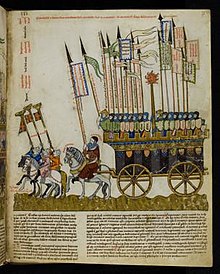Breviculum ex artibus Raimundi Lulli
The Breviculum ex artibus Raimundi Lulli electum , also Electorium parvum , is a manuscript and one of the most important sources on the Catalan philosopher Ramon Llull . It contains the shortest of three compilations of Llull's basic ideas.
History and provenance
The breviculum was created under the aegis of Llull's pupil Thomas le Myésier (d. 1336). It is best known for its twelve full-page miniatures depicting scenes from Ramon Llull's life. Since the manuscript must have been created shortly after Llull's death (1316) under the direct supervision of his pupil in northern France, one can assume that the representations at least come close to its real appearance. This is what makes the pictures so valuable, because true-to-life portraits of people from the Middle Ages are rare. Because of its artistic decoration, it takes on a special role anyway: "Among the large number of manuscripts that pass on the extensive work of the Catalan philosopher, theologian and poet Ramon Lull (Raimundus Lullus), the Karlsruhe Codex is the showpiece."
Thomas le Myésier made three compilations of Llull's main work: the Electorium magnum (today Paris, Bibliothèque nationale , Ms. lat. 15450), the Electorium medium (now lost) and the Electorium parvum (today Karlsruhe, Badische Landesbibliothek , Cod. St. Peter perg. 92). While he probably kept the first two himself, he dedicated the breviculum to the French Queen Joan of Burgundy-Artois and presented it to her as a gift. The manuscript then experienced an eventful history. Initially still in Paris, at the beginning of the 16th century it was owned by a canon at the Cathedral of St. Pierre in Poitiers, western France . He bequeathed it to his two nephews in 1582; what then happened to her is uncertain. In 1736 Ulrich Bürgi , abbot of the Benedictine monastery of St. Peter in the Black Forest , bought it from the Freiburg lawyer Joseph Anton Weigel. When the monastery was secularized in 1806/07 , the manuscript and many other treasures from the monastery library were brought to the court library of the Grand Duke of Baden in Karlsruhe. These manuscripts are now kept by the Badische Landesbibliothek as the direct successor to the court library.
literature
- Felix Heinzer: Codicological description and history of the manuscript , in: Stamm, Gerhard (ed.): Raimundus Lullus - Thomas le Myésier, Electorium parvum seu Breviculum. Commentary on the facsimile. Wiesbaden: Reichert, 1988, pp. 21-32.
- Amador Vega: The life of Ramon Llull: The motion of moving images , in: The thinking machine. Ramon Llull and the Ars combinatoria . Barcelona: CCCB, 2016, pp. 14-37.
- Felix Heinzer / Gerhard Stamm: The manuscripts of St. Peter in the Black Forest, 2nd part: The parchment manuscripts . Wiesbaden: Harrassowitz, 1984, pp. 183-185 (The manuscripts of the Badische Landesbibliothek in Karlsruhe, Vol. 10) Digitized .
Web links
- Digitized in the digital collections of the Baden State Library
- Manuscripts from St. Peter's provenance on the website of the Badische Landesbibliothek
Individual evidence
- ↑ Stamm, Gerhard: "Introduction", in: ders. (Ed.): Commentary volume on the facsimile, Wiesbaden: Reichert, 1988, pp. 13-19, here: p. 13.
